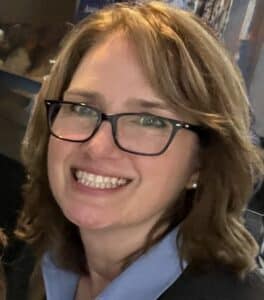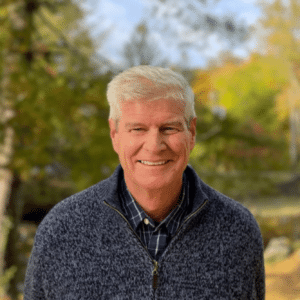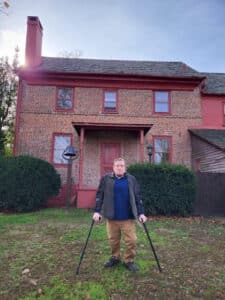2025 February Webinar
Q&A from February Webinar
LOCAL AID & GRANT PROGRAMS
Q: Regarding cuts to Local Aid funding in proposed SFY26 state budget – Given the federal pull back for support for biking and active transportation with both the halt in discretionary grants that fund bike/ped infrastructure and the flagging of bike lane language, the strategy going forward seemed to point to a pivot of more support from the state. However, the new proposed budget cuts local aid funding compared to past years. In 2023 the budget was $20M this year it is only $8M.
There is an increasing concern about where funding will come from for the implementation of the Safety Action Plans including the Action Plan being developed by the Target Zero Commission. Any thoughts on a path forward here would be very welcome.
A: Traditionally, the Safe Streets to Transit, Transit Village, and Bikeways programs are each funded at $1M every fiscal year. In the past, additional funding was made available for these programs, allowing more grants to be awarded, but amounts have varied over the years starting in FY 2021.
The 2024 TTF Reauthorization provides the same level of funding for many Local Aid programs as the previous reauthorization, and Funding for Municipal Aid, County Aid, the Local Bridge Fund, Local Freight Impact Fund, and Local Aid Infrastructure Fund remains consistent with years past.
NJDOT will focus on optimizing the resources provided to support the safety of ALL roadway users – especially our most vulnerable. That remains our top priority.
—
Q: How much state or federal funding is available for Safe Streets?
A: For Fiscal Year 2025, we awarded $17.44M in grant funding for Safe Streets to Transit, Bikeways, and Transit Village. We’ll work to optimize state and federal resources to support the safety of ALL roadway users – especially our most vulnerable.
—
Q: Is there any special/specific DOT guidance regarding transit-oriented villages?
A: The NJDOT-administered Transit Village Initiative provides participating municipalities with planning expertise and grant opportunities to redevelop land near train or other transit facilities in a way that promotes economic activity and the use of public transportation. Transit Village designation provides:
- State of New Jersey commitment to the municipality’s redevelopment vision
- Coordination and technical assistance among state agencies that comprise the Transit Village Task Force
- Priority consideration for certain funding opportunities
CRASH DATA & REPORTING
Q: What is the baseline in NJ of the number of car crashes and number of pedestrian and cyclist fatalities since 2015? Have these numbers been going up or down?
A: According to the latest numbers from NJSP Crash Records – so far this year, crash-related fatalities are down by 18.2% (59 fewer) compared to last year.
- January to July 2, 2024, there were 324 fatalities – 112 of them vulnerable roadway users
- January to July 2, 2025, there were 265 fatalities – 80 of them vulnerable roadway users
This shows a reversal in the upward trend we saw at the start of 2024, when fatalities went up 25.7% compared to the previous year at the same time.
Cumulative Numbers for Last 10 Years:
- From 2015 to July 2, 2025 – 6,067 fatal crashes have occurred on New Jersey roadways claiming the lives of 6,441 people
- Of these victims, 2,350 were vulnerable roadway users, either bicyclists or pedestrians.
- The number of fatal crashes peaked in 2021. That year, 667 crashes took 697 lives, 243 of which were vulnerable roadway users.
—
Q: Information regarding deaths on roadways is readily available on NJSP website. In my mind, this is just the tip of the iceberg. Thousands more are seriously injured every year. Can we develop publicly available “serious injury” data similar to the fatality data?
A: These reports are available under the Crash Records section of NJDOT’s website for the years 2001 through 2022. https://dot.nj.gov/transportation/refdata/accident/id
—
Q: Asbury Park Complete Streets Coalition advocates for safety on city streets for walkers and rollers. Many people in AP do not own cars. This population mainly live in a quadrant of the city where there is less infrastructure to make streets safe, and speeding and reckless driving is rampant. It is difficult to get accurate crash data, and crashes may be unreported. Can there be a database so city leaders can be informed and take action?
A: Same as above
—
Q: What can be done to provide better training to local police and guidance on standards for completing crash reports in order to improve the data captured by Safety Voyager?
A: NJDOT has launched a digital NJTR-1 preparation tool, known as NJ Crash, to help police departments complete NJTR-1 crash reports. Police departments can use the NJ Crash application directly to file crash reports or opt to submit them through a third-party vendor. The platform includes validation rules to enhance report accuracy, and NJDOT applies these validation rules to reports submitted through third-party vendors as well.
NJDOT provides training to police departments (in collaboration with external shareholders) on the completion of reports and the importance of providing correct data. NJDOT also reaches out to police departments to provide guidance when errors are noted.
Currently, there are only 16 agencies (out of 604) that are not using an acceptable electronic crash reporting format. If law enforcement agencies have questions, they can contact Stephen.Choborda@dot.nj.gov who will provide them options on how to submit their NJTR-1 reports in an acceptable electronic format that may include NJ Crash or another third-party vendor. Agencies can use this link to learn more about the NJ Crash platform.
4-FOOT SAFE PASSING LAW
Q: Will NJDOT publicize the 4-Foot Safe Passing Law which went into effect in March 2022? Drivers and police still seem not to know about it.
A: NJDOT has begun installing 4-Foot Passing signs in appropriate locations on state roadways and we encourage counties and municipalities to do the same on roadways under their jurisdiction. We also created two videos that we used to promote this law on social media – one video ran in February 2023, and one in June 2023. We will promote this more on our social media channels and incorporate into the public awareness messaging currently running throughout the state.
COMMUNICATING WITH ADVOCATES
Q: How would the Commissioner like local advocates to alert NJDOT to problem areas or, even better, potential solutions? One example is crossing U.S. 1 in West Windsor … so many poor choices yet Princeton University has built a path that almost reaches U.S. 1 at Fisher Place, where there is a pedestrian signal along with the traffic light. Princeton U says it built the path to align with a Route 1 widening (if and when that happens) but would connect it to U.S. 1 to create a safer route between Princeton U and West Windsor … but it needs NJDOT’s blessing. As an advocate trying to make this happen, it is very difficult to engage with NJDOT directly to just start a discussion. What is the best method or process for local municipalities to engage with the NJDOT on issues like this?
A: I invite you to email me directly at fran.oconnor@dot.nj.gov.
Let us know about problem areas, even if they are on local roads, and we will try to address them or help facilitate with local governments. The best method of engaging with NJDOT is through our Office of Constituent Relations online form or by calling 609-963-1982 (press option 8).
NJDOT’S BUREAU OF SAFETY, BICYCLE & PEDESTRIAN PROGRAM
Q: The Bureau of Safety, Bicycle and Pedestrian Programs within NJDOT provides bicycle and pedestrian technical assistance (TA) to communities. But they are short-staffed and under-resourced. Will NJDOT provide more resources so they can hire enough consultants to provide TA, and enough staff to act as advisors to communities?
A: NJDOT acknowledges the many local governments have challenges in advancing state and federally funded transportation projects. To assist, the NJDOT Local Aid Resource Center provides guidance to local governments with grant applications and the project delivery process.
Local governments are also encouraged to work with their respective MPOs to discuss and prioritize local planning studies. In addition, the department continues to examine its policies and practices to better serve our stakeholder groups in carrying out the department’s mission.
The FY26 Governor’s Budget provides for $20 million in funding for staff augmentation, a reduction of $5 million, from the FY25 appropriated amount of $25 million. This funding is used for the engagement of specialized consultant staff to augment the existing workforce. The department ‘s human resources team is actively recruiting and filling open department positions.
—
Q: What can be done to ensure that when Technical Assistance from the Bureau of Safety, Bicycle & Pedestrian Programs results in a mobility plan that includes safety improvements on state routes, there is coordination with other DOT units/departments to ensure those recommendations are addressed?
A: Depending on which type of technical assistance needed, there are different options and requirements.
For Local Pedestrian and Bicycle Planning Study Assistance projects, NJDOT requires a local government resolution of support prior to beginning the planning study work. If the study results in recommendations for NJDOT roadways, the report is taken under advisement, but work (particularly safety work) is prioritized mainly on safety ranking. This ensures that limited resources are prioritized across the entire NJDOT network, not just on the challenging areas covered in one local study. If the area is ranked Statewide, it is likely already in the pipeline for improvements regardless of the study recommendations.
INTERSECTION IMPROVEMENT MEASURES
Q: All-way pedestrian crossing phase, also referred to as a scramble signal, is a signal phase where all vehicle movements are stopped, and all pedestrian movements are permitted. Pedestrians may travel along all crosswalk legs and potentially even in a diagonal movement across the intersection. Right turn on red should be prohibited during all way pedestrian crossing phases. This treatment is most appropriate in areas of high pedestrian crossing demand.
Research shows that pedestrian groups are less cautious, so at these heavy pedestrian areas (particularly around schools), it seems like this would improve safety as left turns are often in conflict with pedestrian flow. Drivers get impatient and drive aggressively, so separating turns for cars and pedestrians seems like a useful approach. Are there any data around the use and safety of these All-way pedestrian crossing phase signalized intersections in the state?
A: Exclusive pedestrian crossing phases were installed at these three intersections in Princeton:
- Rt. 27 & Rt. 206 (installed 4/29/2010)
- Rt. 27 & Witherspoon St. (installed 12/9/2024)
- Rt. 27 & Washington Rd. / Vandeventer Ave. (installed 6/10/19)
We are currently analyzing the data with a five-year lookback for comparison, but this is one of the many intersection safety measures we consider when making improvements.
LAW ENFORCEMENT & SPEED LIMITS
Q: Can the Target Zero Commission support more work to review current roadway speed limits along state highways where chronic speeding contribute to crashes? Not only enforcing but reducing roadway speeds have proven successful on local roads.
A: NJDOT follows the current Manual on Uniform Traffic Control Devices (MUTCD) for setting speed limits on state highways by an engineering study. As the MUTCD indicates, NJDOT considers the following:
Roadway environment (such as roadside development, number and frequency of driveways and access points, and land use), functional classification, public transit volume and location or frequency of stops, parking practices, and pedestrian and bicycle facilities and activity
- Roadway characteristics (such as lane widths, shoulder condition, grade, alignment, median type, and sight distance)
- Geographic context (such as an urban district, rural town center, non-urbanized rural area, or suburban area), and multi-modal trip generation
- Reported crash experience for at least a 12-month period
- Speed distribution of free-flowing vehicles including the pace, median (50th-percentile), and 85thprecentile speeds
- A review of past speed studies to identify any trends in operating speeds
—
Q: Does NJDOT support speed cameras? NJ had the highest number of pedestrian fatalities in 30 years in 2024. Speed kills, and police cannot and should not be expected to enforce speeding everywhere.
A: We will continue to work closely with our law enforcement partners, but NJDOT does not take a position on the use of speed cameras.
—
Q: Is there any talk on the horizon of lowering the Blood Alcohol Content, (BAC), level from 0.08 to 0.05 and become the 2nd state in the nation to do so? It will save lives.
A: The Target Zero Commission will be exploring many strategies to include in the Action Plan and will include this as something to consider.
—
Q: Drivers will speed when it is possible/comfortable to do so. Roads need to be designed so it’s uncomfortable for drivers to speed. How can NJ change the built environment on local roads like RT 71 Main Street in Asbury Park?
A: NJDOT is always looking for ways to enhance the safety of roadways, when and where it is appropriate. Road diets, like the one implemented on Route 71 in Asbury Park, are just one way to reconfigure the roadway to improve safety and mobility for all users of the road while relieving vehicular congestion. In the past, road diets have been implemented on Route 45 in Woodbury, Route 9 in Lakewood, Route 168 in Munt Ephraim and Haddon Heights, and on the Route 71 Bridge over Shark River.
NJDOT is in the process of making safety upgrades at 10 of the most dangerous intersections in the state, with expected completion by fall 2025. These intersections include Route 129 and Lalor Street and Route 129 and Cass Street in Trenton, where initial improvements were made in 2022. An upcoming Capital Program project will make more extensive safety improvements to Route 129. The Route 129, Route 29 to Route 1 Safety Improvement project is in Concept Development with construction expected to begin in 2030. This project will redesign the road to add gentle curves, where possible, which are expected to reduce speeds.
DRIVERS’ EDUCATION
Q: How can adult drivers who are beyond taking regular drivers’ education be reached by the Target Zero effort? What role does teaching drivers better car control skills have in this program?
A: The Target Zero Commission will be working closely with the Motor Vehicle Commission as we develop the Target Zero Action Plan to explore how we can improve or reinforce driver’s education, both as part of the initial licensing process and ongoing as drivers age.
—
Q: Has NJ instituted continuing education requirements for driver’s license renewals as suggested by Mr. O’Connor? This would be an excellent opportunity to reach drivers with educational outreach, even if it is as simple as a compulsory 5-10 minute video during the license renewal process. Noting that every other state license already has CEU requirements.
A: Same as above
—
Q: Can driver retesting be considered for all drivers every 20 years? An educational refresher course of new traffic laws, laws relating to interaction with pedestrians, cyclists & micromobility users as well as a driving skill test to remind drivers how to drive when vulnerable road users are present AND the penalties for speeding, aggressive driving, and other dangerous practices.
A: Same as above
PEDESTRIAN SAFETY AROUND SCHOOLS
Q: Involvement with schools isn’t just about teaching kids about traffic/driving safety. How can NJDOT address the needs of kids and families to enable them to get around safely to and from school, and within our communities? When streets are designed for kids, they’re safe for everyone.
A: Let us know about problem areas, even if they are on local roads, and we will try to address them or help facilitate with local governments. The best method of engaging with NJDOT is through the Office of Constituent Relations.
EQUITY & COMPLETE STREETS
Q: How do you see incorporating equity into the Safety Plan? Can Complete Streets be a central feature?
A: Every community deserves safe, reliable, and accessible transportation. Our work at NJDOT, and the work of the Target Zero Commission, is about making sure that every corner of our state sees the benefits of safety improvements and initiatives. We announced the updated 2024 Complete Streets policy in December, and this will used in the development of the Action Plan.
WORKING WITH LOCAL GOVERNMENT
Q: How will the Safety Action Plan build on the Local Safety Action Plans being created in every county?
A: The Voorhees Transportation Center (VTC), on behalf of The Target Zero Commission, is leading the Target Zero Action Plan working group which is the mechanism to provide input into the Action Plan.
Local governments, advocacy groups and individuals wanting to participate are invited to contribute to the process by submitting ideas through the NJ Target Zero Action Plan Input Form.
—
Q: Asbury Park recently adopted a Vision Zero Policy. How can our city and other cities partner with the state to further the goal of zero traffic injuries and deaths in the state?
A: We encourage Local Governments who have already adopted Vision Zero Policies to review the requirements of the NJDOT’s Local Bicycle/Pedestrian Planning Assistance Program (LBPPAP) and submit an application.
It’s important to note that unlike the state funded grant programs administered through our Local Aid unit, which have annual solicitation cycles, applications for the LBPPAP are accepted at any time. The program is competitive there may be more applicants than resources available in any given year.
CROSS-AGENCY COLLABORATION / PROGRAMS
Q: 20 years ago, NJDOT worked with the Office of State Planning and NJDEP to help communities plan for walkable and bikeable towns. Gov Christie terminated that. What will it take to resurrect that program? Communities just don’t have the resources to do this alone.
A: NJDOT continues to work with our state partners, including the New Jersey Department of Environmental Protection (NJDEP), to make our roads safer for vulnerable roadways users. For example, NJDEP is one stakeholder in the Transit Village Program.
Additionally, NJ Transit and NJDEP are spearheading the Greenway project. This project will emulate the New York City High Line, which transformed an abandoned elevated train track into more than one mile of walkable space in Manhattan. The Greenway will be much bigger, utilizing eight to nine miles of former railroad tracks to provide a walkable and bikeable corridor connecting communities from Jersey City to Montclair – communities that need public space and open access. On July 15th, Governor Murphy joined local, county, and state officials in Newark to break ground on the first phase of the project, and expects a large section of the Greenway to open before the end of his governorship.
—
Q: How will the Target Zero Commission engage with the Metropolitan Planning Organizations?
A: The Target Zero Commission includes representatives from all three Metropolitan Planning Organizations, so they are at the table and actively involved.
—
Q: How will the other transportation agencies in the Target Zero Commission work to prioritize the safety of vulnerable users in their operations outside of the committee.
A: This is a question for the other agencies in Target Zero Commission.
PUBLIC TRANSPORTATION
Q: I find “you get what you measure” is key to successful programs. For Target Zero, could we also measure (and aim for) decrease in car trips state-wide as new infrastructure allows people to replace car trips with alternative transportation? and likewise decrease in congestion?
A: New Jersey has made significant investment in transit infrastructure that will ease congestion on our roadways by offering alternative transportation options to commuters.
The Portal North and Hudson Tunnel projects will expand transit access between New York City and New Jersey by replacing the Portal North Bridge and building two new tunnels under the Hudson River.
NJ Transit is also making improvements to existing infrastructure under the transit-oriented development. Renovations to improve train stations in communities like Woodbridge and Hamilton are underway. Once completed, these fully transformed transit facilities will provide an attractive alternative to customers considering transit over commuting in a car.
NJDOT and NJ Transit oversee the Transit Village initiative, which provides incentives for municipalities to redevelop or revitalize the areas around transit stations using design standards of transit-oriented development (TOD) to plan vibrant, pedestrian-friendly neighborhoods where people can live, shop, work and play without relying on automobiles.
NJDOT’s Local Aid Resource Center also funds the Safe Routes to School initiative, which makes the necessary improvements on local roadways to increase safety for school children who are or would like to walk or bike to school. This provides many healthful benefits for students and the community by increasing the health and mobility of school-age children; reducing congestion, air pollution and traffic conflicts around schools; and teaching safe pedestrian, bicyclist and driver skills.
—
Q: One of the best safety tools is fewer people driving, therefore fewer incidents of traffic violence. Will the Commission’s holistic view include a focus on reducing Vehicle Miles Traveled (VMT), through mode shift and providing quality infrastructure and operations for those that travel outside of motor vehicles?
A: Same as above














































































